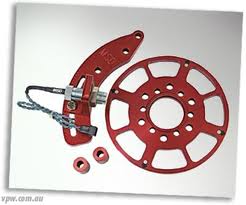Product Description
Here is a Crank Trigger kit, for a small block Ford engine.
Includes crank trigger wheel, sensor mount and adjustable sensor mounting bracket.
A crank triggered ignition system can make more horsepower than a distributor triggered system. A crank triggered system can often make more power and produce more consistency due to its inherent timing stability. A crank trigger system is typically composed of three main components: a trigger wheel, pickup, and a pickup mounting bracket. Although the triggering components in a distributor or Pro Mag generator are very similar, there is one major difference - they are connected to the crankshaft through a series gears, shafts, belts, and other drive assemblies. Typical power transmission components include, but are not limited to, the cam drive (gear or belt), camshaft, and an offset magneto drive that also utilizes gears or belts. From the instant the throttle is opened to the second the chutes are pulled, the engine operating conditions are changing. Although the driver may never lift off the throttle, engine and drivetrain harmonics can wreak havoc on timing stability. Torsional vibrations in the camshaft and subsequent drive assemblies can combine to produce staggering fluctuations in ignition timing.
Having described the shortcomings of a conventional ignition trigger system, it should become apparent that the crankshaft is the most logical place to obtain a stable trigger.


Photo etched, 1/25 scale
















